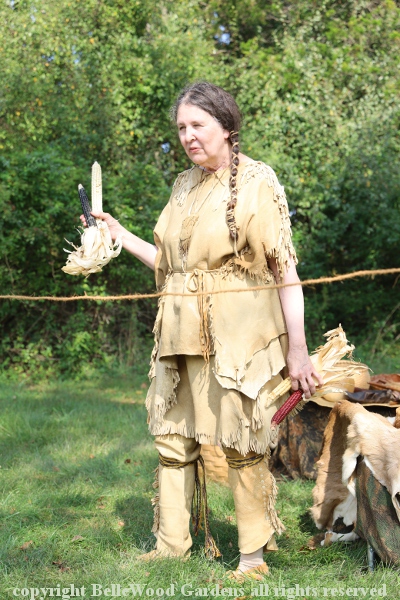
Cooperative weather. We're outside on the grounds of the Bouman-Stickney Farmstead.
A slack rope separates presenter and her audience, comfortably seated on folding chairs.
.
If you have any comments, observations, or questions about what you read here, remember you can always Contact Me
All content included on this site such as text, graphics and images is protected by U.S and international copyright law.
The compilation of all content on this site is the exclusive property of the site copyright holder.
Lenape Lifeways program at Bouman Stickney Farmstead Museum
Sunday, 3 October 2021
Depending on the time of year programs at the Bouman Stickney Farmstead might be indoors or outside. Open hearth cooking, downstairs with the walk-in fireplace, in December Dutch Christmas when Sinterklaas makes a visit. Outdoor programs . . . I remember one about tea and toddies, with an outdoor segment about brewing. But especially now, in these days of covid-19, outdoor programs are the order of the day.
Today Susan McLellan Plaisted, proprietress of Heart to Hearth Cookery in Bucks County, Pennsylvania, is presenting a program on Lenape lifeways focusing on foodways, gardening and foraging, discussing the use, processing and preservation of grown, hunted and foraged foods.

Cooperative weather. We're outside on the grounds of the Bouman-Stickney Farmstead.
A slack rope separates presenter and her audience, comfortably seated on folding chairs.
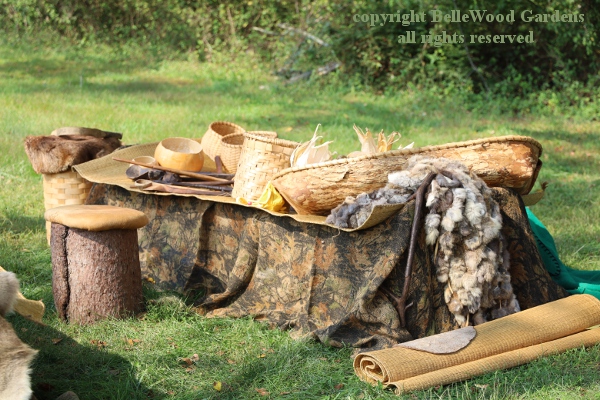
There are displays set up on tables, with woven baskets,
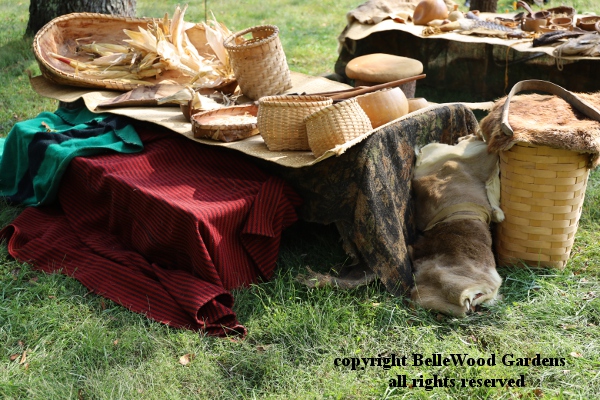
ears of dried corn, gourd containers, deer skins.
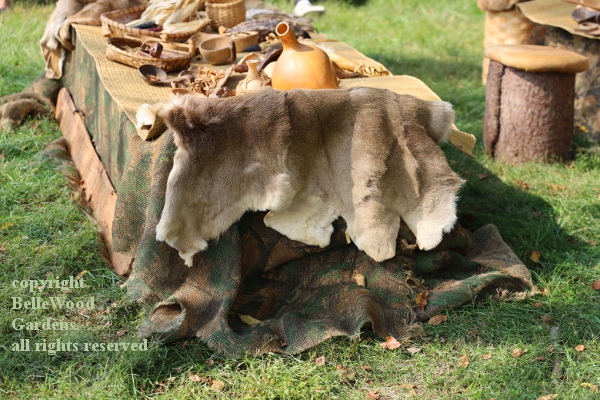
I did not stay for all three hours. The portion I did listen to was about corn.
First of all, what is corn? In the North America, the United States and Canada, corn is that food plant first grown in Mexico. Kernels are held on a cob wrapped in a leafy sheath or husk. Confusingly, European settlers use "corn" to describe other cereal grains. In 17th century England, corn referred to wheat, in Scotland, corn meant oats, while in areas of Germany, corn referred to rye. Which is one of the reasons what we call corn they call maize.
What Susan focused on, however, was "corn" as a descriptive for particle size. Corn just meant a small particle. An ear of corn with all those rows of kernels . . . To corn beef was to pack it with a small particles - salt, peppercorns, mustard seed, and more.
Susan grows Lenape corn, beans and squash from original seed and processes puhwem (Lenape white flour corn) into hominy. She explained about nixtamalization, treating dry corn kernels with lye from wood ashes to loosen the hulls. Not only does it make the corn easier to grind into flour, it increases the availability of niacin. This makes corn more nutritious, and reduces the risk of vitamin deficiencies such as pellagra. Also, the dough made from nixtamalized corn holds together better than flour made from dry corn that has not been so treated.
By the way, my brother, an anthropologist, taught his first born son (while still a toddler) to reply to the query "What are corn and beans?" to answer, "Complementary amino acids." That's right. Corn and beans, eaten together, provide complete protein.

Susan is pulling off the tightly wrapping husks that cover a dry ear of puhwem.
The very best corn from the harvest would be saved for sowing next year's crop.
The Lenape puhwem corn was 8-rowed. To maintain this seed strain she grows
in the traditional form, if any of the harvested cobs are 10-rowed she eats them.
An aside. When I was a child and our family was spending summers at my aunt's cottage in Brookfield, Connecticut, we used to eat green corn. Not that the kernels were colored green. It was immature field corn, when the kernels are filled with milky white fluid. Even better was 'Country Gentleman', a white corn that was developed for eating fresh. Today that cultivar is considered an heirloom variety, replaced by more modern, super sweet cultivars.
Susan shows us a deer jaw bone, used to cut and scrape the corn kernels off the cob. On her Heart to Hearth cookery blog she mentions using green corn, puhwem in the milky stage, to make green corn bread using leaves from the corn plant filled and folded. Sort of like the more familiar tamale, I suppose.
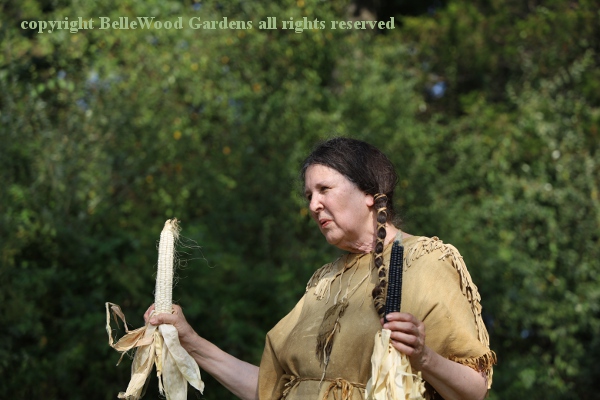
In her left hand Susan holds an mature, dry cob of Lenape blue flint corn.
The Lenape name, sehsapsing, means "that used to make sapan", a traditional cornmeal mush. When mature and dry, it was / is also ground for flour and grits. Susan mentions bread, describing it as a flat cake, 6 inches in diameter and an inch high, cooked on stones set around a fire pit. "Bread" as a default name, I think, since corn has no gluten and no leavening - yeast, baking powder, baking soda - was involved. Sapan was offered to visitors, and as a carbohydrate also an important part of daily food.
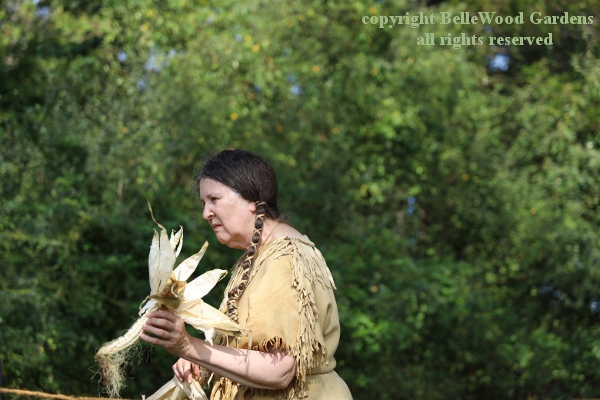
We may think of corn silk as a nuisance, especially when the thread-like strands get stuck between our teeth as we eat corn on the cob. The Lenape dried and saved "that which is hair-like", using it to make tea to treat bladder infections.
Beans and squash were other cultivated vegetables that together with corn make up the Three Sisters triumvirate. Plant corn first. When is begins to grow, plant the beans. Puhwem grows very tall, as much as 12 feet or more, so it makes a good support. Then, when the bean vines are climbing, plant squash. This makes such an excellent combination: beans add nitrogen to the soil, a nutrient that corn uses. Then the large leaves of squash plants act to suppress weeds. Very practical and functional, and very foreign to European settlers .
I was not around for the remainder of the program but expect that foraged foods in season at this time of year would include nuts (those acorns, hickory, and black walnuts bombarding my driveway!) Indian potatoes, Apios americana, which I had naturally occurring in Wilton, Connecticut, is a perennial vine that bears edible beans and large edible tubers. Jerusalem artichoke, Helianthus tuberosus, is a widely distributed native sunflower that can often be found in supermarket produce sections. Fruit would include grapes and persimmons.
An online search brought me to TrueLove Seeds, a Pennsylvania farm-based seed company that appears to offer a very nice selection of culturally important and open pollinated vegetable, herb, and flower seeds, including Lenape puhwem and blue corn.
Two other display areas attracted my attention. One, with arrowheads and stone tools found in the area. And the other
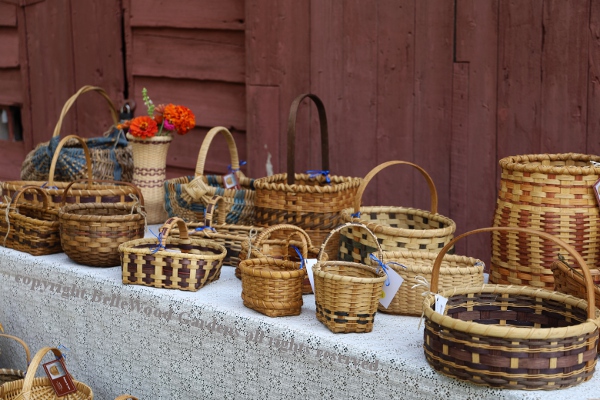
had display of finished baskets, and a woman weaving one.
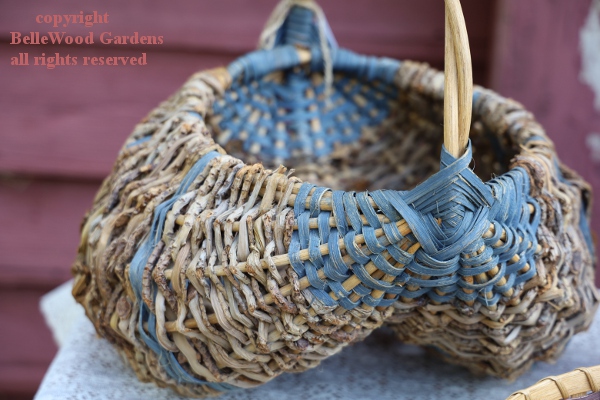
Nearly all the baskets were make of commercial, purchased splints and reeds.
This saddle style basket is made of honeysuckle, I think, and blue dyed splints.
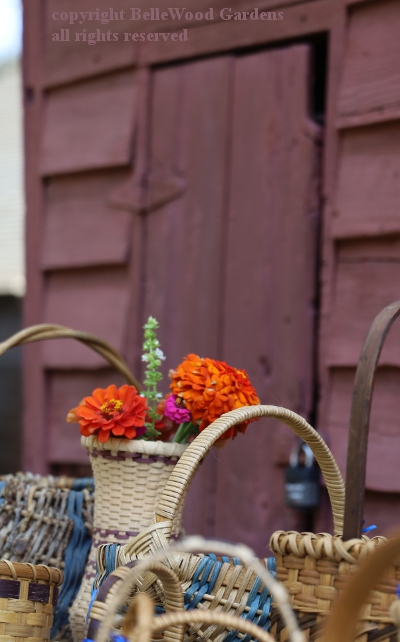
One of the baskets has a bouquet of zinnias, picked in the Bouman Stickney
fenced garden. Margaret tells me that their zinnias reseed. That's exciting!
One more program to finish the season here at the Readington Township farmstead museum.
On Sunday, October 10 at 3:00 p.m. The Hunterdon Harmonizers will share their unique a cappella vocal talents in a medley of songs from the golden years of Broadway, including selections from the Lindsay/Crouse musicals The Sound of Music and Anything Goes. A popular event, the registration list is already full. But perhaps more folding chairs can be set up outside the barn. And there's always next year, with more fascinating, informative, and enjoyable programs at the Bouman Stickney Farmstead Museum.
Back to Top
Back to October
Back to the main Diary Page